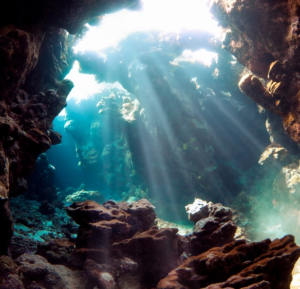Science & Data Document Library
Science and Data Resources
Evaluation of the Aquifer and Springflow Impacts Associated with the Cibolo Creek Transfer Rules

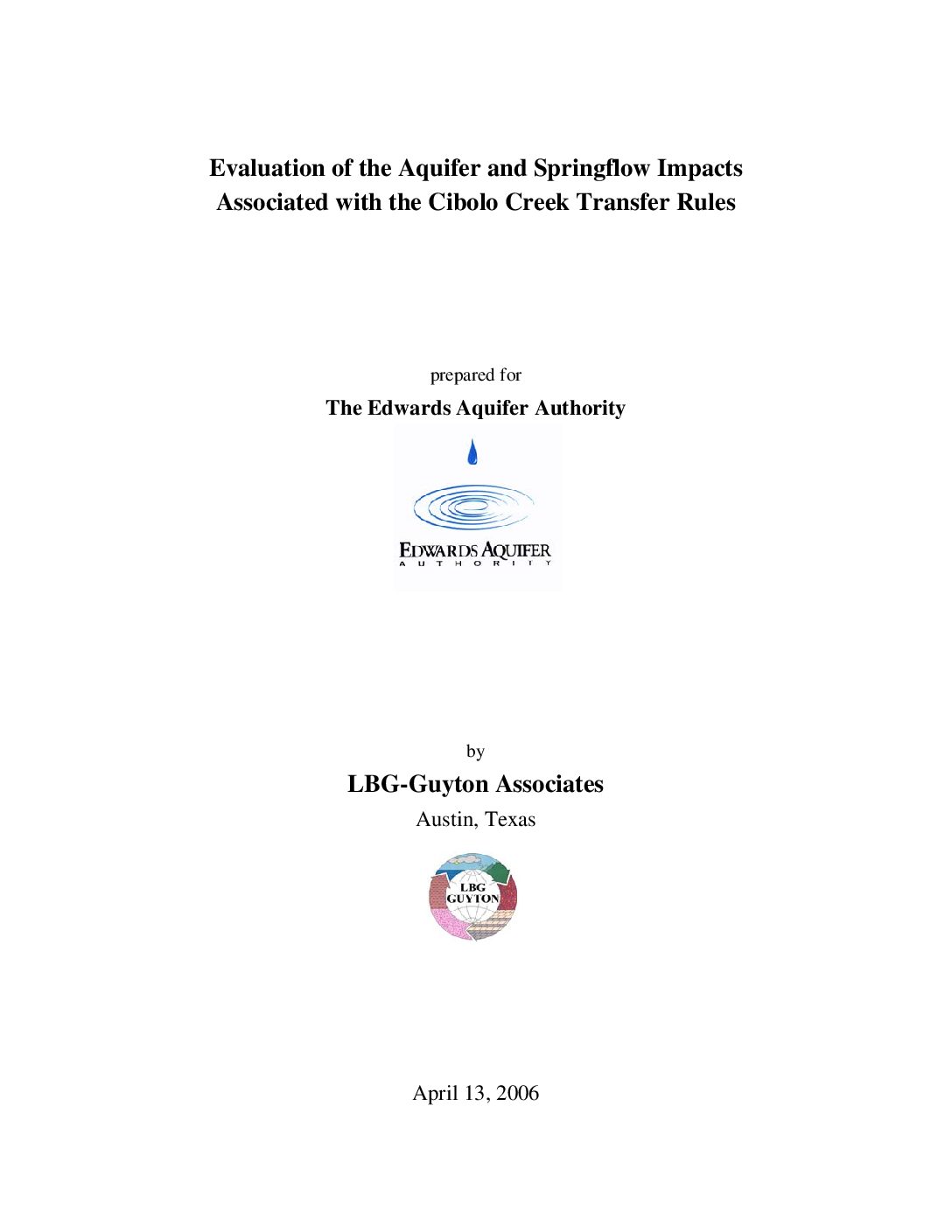
Description: Use of data and modeling to determine effects on springflow in Comal and San Marcos Springs from Cibolo Transfers (transfers of permits from Bexar to eastern counties)
Location: Bexar County, Hays County, Comal County
Summary:The purpose of this study was to use available data and the Authority's MODFLOW groundwater model to assess the impact to aquifer water levels and springflow from the transfer of water rights from Bexar County and the western counties to Comal and Hays Counties. Water right transfers from Bexar County and west into Comal and Hays Counties are referred to as Cibolo transfers because Cibolo Creek is the geographic feature between the two areas. The study was completed on April 13, 2006 by LBG-Guyton Associates, Austin, Texas.
This study was designed to use available data and the EAA MODFLOW groundwater model to assess the impact of Cibolo transfers on aquifer water levels and springflow.
An evaluation of current permits and transfers show that 58 percent of the transfers originate in Bexar County, followed by Medina (26%) and Uvalde (16%). Transfers make 0.51 percent of total permits. Comal County receives the largest portion of transfers (94%) followed by Hays (4%), and Guadalupe (2%).
Assessment of the faults and springs in the MODFLOW model indicates that the model is generally consistent with the current conceptual model of the aquifer. Based on the modeling methodology used for this study, it is clear that Cibolo transfers impact springflow from San Marcos and Comal Springs.
The model results indicate that the withdrawal location of the transfer can affect the amount of impact that the transfer has on flow from individual springs and on the total springflow. Cibolo transfers generally have a negative effect on San Marcos springflow because San Marcos Springs are located at the end of the flow system, and thus are generally affected by upgradient withdrawals. Model results indicate that on average, San Marcos springflow may be decreased from 0 to 92% of the transfer volume. In seasonally high summer pumping, San Marcos springflow may be decreased from 4 to 313% of the transfer volume. Model results indicate that on average, the impact to Comal springflow ranges from a 51% increase to a 35% decrease of the transfer volume. During peak summer pumping, the maximum impact to Comal springflow ranges from an increase of 7 percent to a decrease of 203 percent of the transfer volume.
Water levels in the Bexar County index well (J-17) increase slightly due to transfers, suggesting that CP/DM triggers for the San Antonio pool would be reached slightly later during any particular dry period then they would have prior to the transfer.
Edwards Aquifer Hydrogeologic Report for 2000

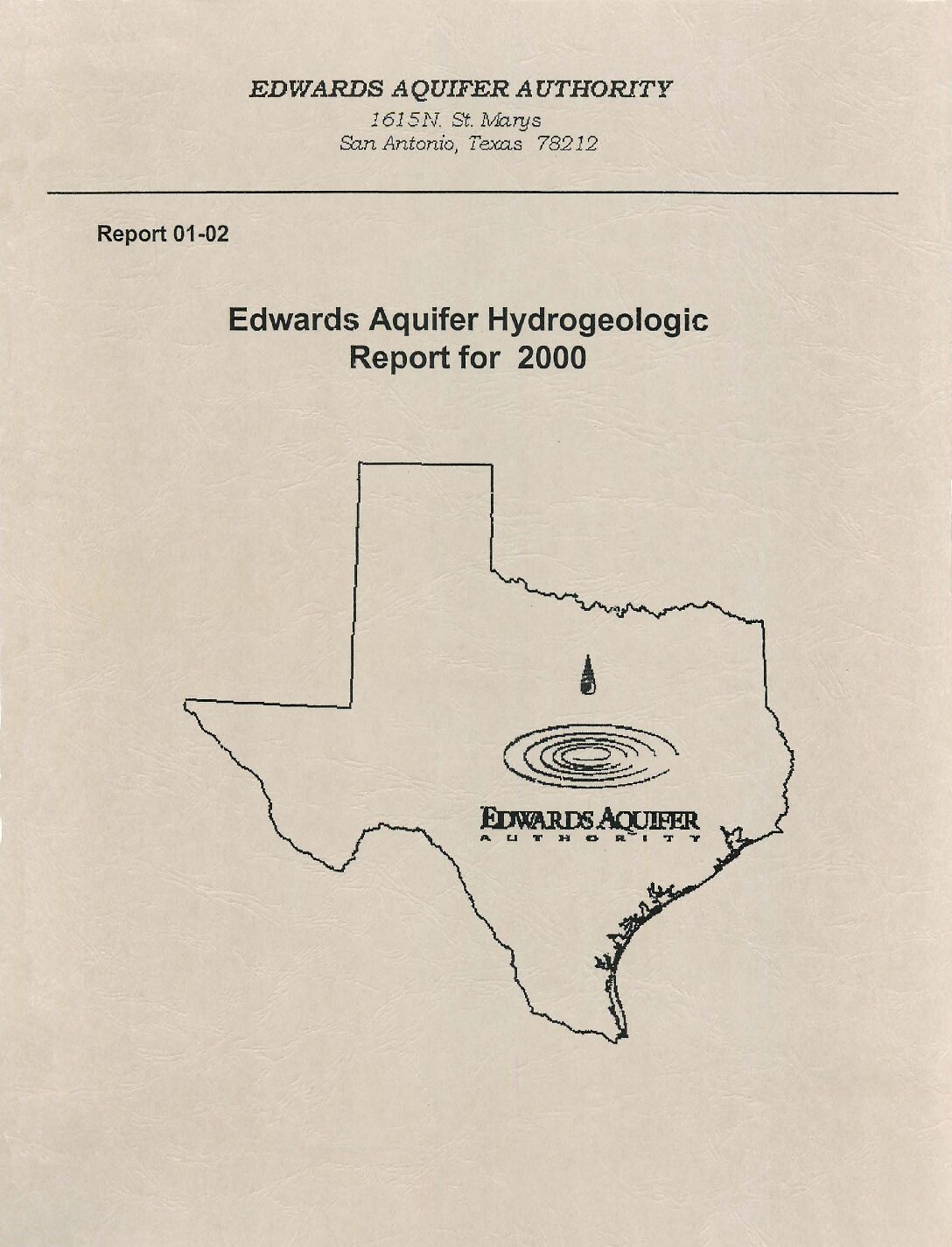
Description: Annual report for 2000 on recharge, discharge, water levels and water quality in the Edwards Aquifer San Antonio Region
Report Number: 2-Jan
Location: Edwards Aquifer - San Antonio Area
Summary:(Excerpted from the report Summary)
In 2000, total discharge from the San Antonio segment of the Balcones fault zone Edwards Aquifer (the aquifer) exceeded recharge. Above average rainfall in the later portion of the year resulted in a net gain in aquifer storage as demonstrated by higher water levels in most index wells at the end of the year relative to the beginning of the year. The net increase in the Bexar County index well for 2000 was 13.1 feet. The amount of rain received in the San Antonio area in 2000 was approximately 19% above average.Recharge in 2000 was estimated to be 614,500 acre-feet.
In 2000, the following minor element metals were detected at or above a drinking water standard (Standards in 40 CFR Part 141, 40 CFR Part 143, and EPA's lead and copper rules): Lead Mercury Cadmium
The cadmium concentrations above the MCL were detected in water samples from freshwater/saline water interface monitoring wells. The lead and mercury concentrations were detected in freshwater wells at concentrations just above the MCL. These wells will continue to be monitored for minor element metal concentrations to assess any trends of concern.
Water samples from three freshwater/saline water interface monitoring wells in Bexar County and five freshwater/saline water interface monitoring wells in Hays County contained fluoride concentrations above the MCL of 4.0 mg/L. Water samples from several other wells, primarily freshwater/saline water interface monitoring wells, contained fluoride above the secondary drinking water standard of 2.0 mg/L. These fluoride concentrations are believed to be naturally occurring.
Water samples from several wells contained nitrate concentrations above the MDL. However, none of the nitrate concentrations exceeded the MCL. In general, relatively higher nitrate concentrations were detected in the Uvalde area.
The VOC tetrachloroethene (PCE) was detected in a well in Uvalde County (YP- 69-51-114) at a concentration of 7 µg/L. The MCL for tetrachloroethene is 5µg/L. The TNRCC is working with the responsible party to address the tetrachloroethene contamination.
Comal and Hueco springs were sampled numerous times in 2000 in response to a release of approximately 2,800 gallons of diesel fuel from an above ground storage tank. The release occurred in January 2000 on the recharge zone approximately four miles southwest of New Braunfels. VOCs and SVOCs of an unknown origin were detected at Comal and Hueco springs in late January and early February 2000. The VOC and SVOC concentrations were not detected in subsequent samples collected from Comal and Hueco springs. No VOCs or SVOCs were detected at San Pedro or San Marcos Springs. The VOCs and SVOCs detected at Comal Springs were: 2-methyl naphthalene naphthalene total xylenes.
The VOCs and SVOCs detected at Hueco Springs were: 2-methyl naphthalene naphthalene. The origin of the VOCs and SVOCs detected at Comal and Hueco Springs continues to be investigated.
Edwards Aquifer Authority Hydrologic Data Report for 2006

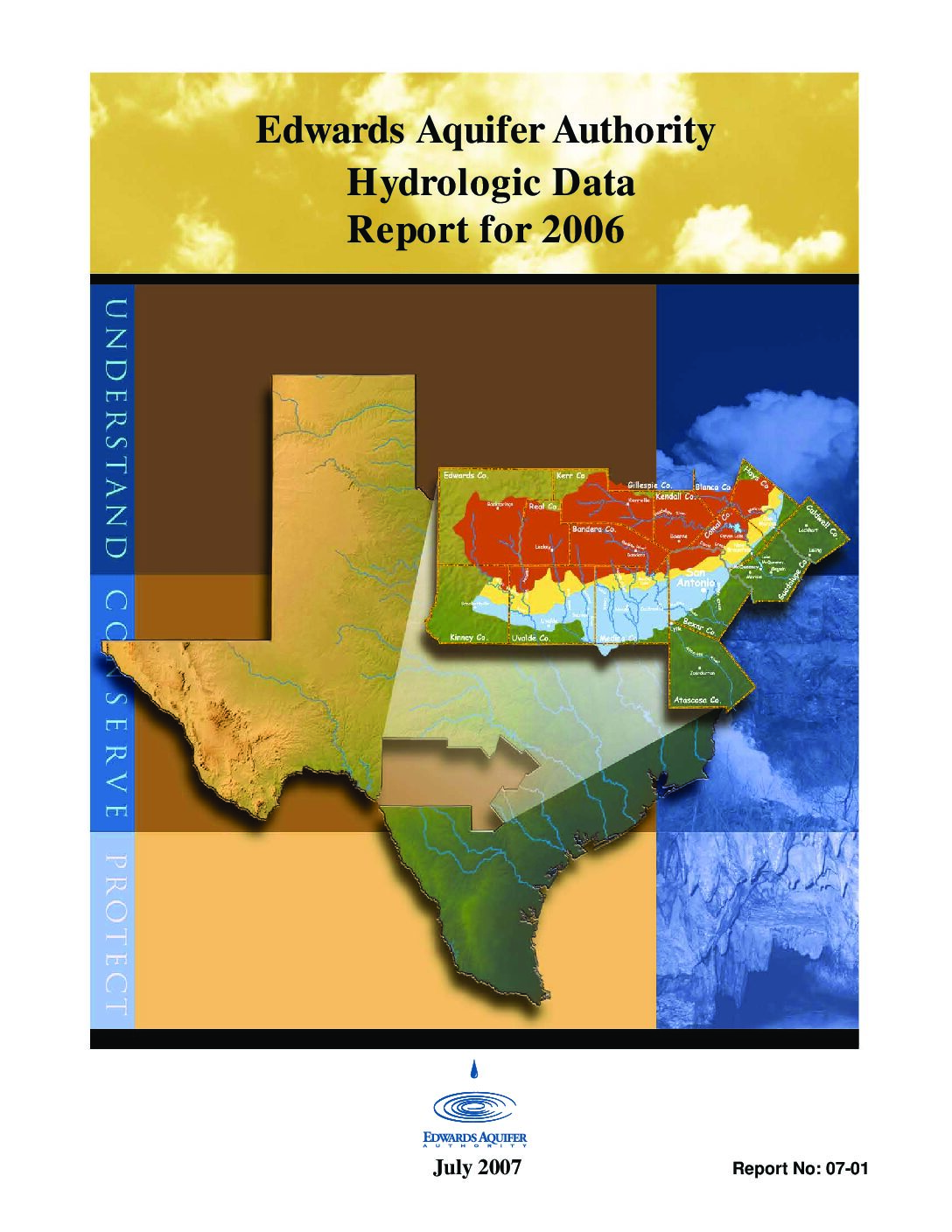
Description: Annual report for 2006 on recharge, discharge, water levels and water quality in the Edwards Aquifer San Antonio Region
Report Number: 1-Jul
Location: Edwards Aquifer - San Antonio Area
Summary:(Excerpted from report Summary)
This report presents results of the Authority's Edwards Aquifer Data Collection Program for calendar year 2006.
Water levels were generally below the historical mean value at the Bexar County (J-17) index well throughout 2006. Other wells in the region exhibited similar behavior. In 2006, aquifer (groundwater) levels were adversely affected by the continuing drought conditions across the region, resulting in water levels that were lower than those recorded in calendar year 2005.
Precipitation in the Edwards Aquifer region was below the period of record mean in 2006.Total recharge to the Edwards Aquifer was 201,600 acre-feet in 2006, or approximately 36 percent of the median value of 560,900 acre-feet for the period of record (1934-2006).In calendar year 2006, groundwater discharge from the Edwards Aquifer through wells and springs totaled 768,400 acre-feet. This amount is approximately 12 percent above the median value of 683,500 acre-feet for the period of record (1934-2006).
Water samples from most sampling events were analyzed for major ions, metals, TDS, hardness, and nutrients. Wells and spring groups were also analyzed for VOCs. Water samples from 10 wells and all spring groups were analyzed for SVOCs. Water samples collected from wells, stream locations, and spring groups were also analyzed for pesticides, herbicides, and PCBs.
For well water samples collected in 2006, mercury was detected at one location in the saline zone at 2.7 μg/L, slightly above the 2.0 μg/L MCL. Other metals detected included strontium and iron, at concentrations above their respective PCLs, or secondary standards. Surface water sample analyses did not indicate the presence of any analyzed metals above their respective standards. Spring water samples indicated the presence of mercury, thallium, and antimony at concentrations below MCLs and PCLs in 2006.
For samples collected in 2006, nitrate-nitrite as nitrogen concentrations ranged from below the laboratory reporting limit of 0.015 mg/L to 6.70 mg/L in samples from wells, streams, and springs in the Edwards Aquifer region.In 2006, wells and springs were all analyzed for VOCs; carbon disulfide was detected at trace amounts in Hays County, as was chloroethane. These detections were well below their PCL values. In addition, these detections were from wells within the saline water zone of the aquifer. Laboratory quality assurance data indicated the presence of carbon disulfide in the associated trip blanks.
No SVOCs were detected at or above their associated MCLs in wells sampled. However, the compound bis(2-ethylhexyl)phthalate was detected at 11.4 μg/L in the sample from Las Moras (Fort Clark) Springs. The MCL for bis(2-ethylhexyl)phthalate is 6.0 μg/L. One additional SVOC, phenol , was detected in this sample at concentrations below the MCL. The pesticide compound malathion was detected in a well in Uvalde County in trace amounts.
Edwards Aquifer water is generally of such high quality that it normally requires only chlorination to meet public drinking water standards. However, detection in the aquifer of nitrates and organic compounds, as well as trace quantities of metals, is a concern, and the Authority will continue to monitor for these compounds to determine possible sources and trends. Nitrate as nitrogen was detected frequently in all sample types; however, well samples had the highest concentrations, with 24 of 76 wells sampled testing positive for nitrate-nitrite at 2.0 mg/L or higher. One of the 76 wells had nitrate-nitrite concentrations above 5.0 mg/L; the MCL for nitrate-nitrite is 10 mg/L.
Confirmed detections of anthropogenic compounds, such as malathion from a Uvalde County well and SVOC detections at Las Moras Springs, are a concern and warrant continued monitoring in the future. The Authority's aquifer-wide water-quality sampling program will continue to monitor wells, streams, and springs for indications of water-quality impacts throughout the region.
In addition to the routine water quality samples discussed previously, the Authority collected 123 special samples from 24 wells in response to the release of raw sewage over the recharge zone of the aquifer at two different locations in 2006. The first incident occurred between December 2005 and January 2006, at Evans Road and Highway 281 in north Bexar County. The second incident occurred in Hollywood Park, also in north Bexar County. Both incidents occurred as a result of failed pressurized sewer lines. Although some bacterial samples were positive, none of the samples indicated a positive interception of the anticipated plume of sewage.
Final report as required by the Endangered Species Program, Texas: grant no. E-38-HP: endangered and threatened species conservation: habitat conservation planning for the development of the Edwards Aquifer Authority habitat conservation plan

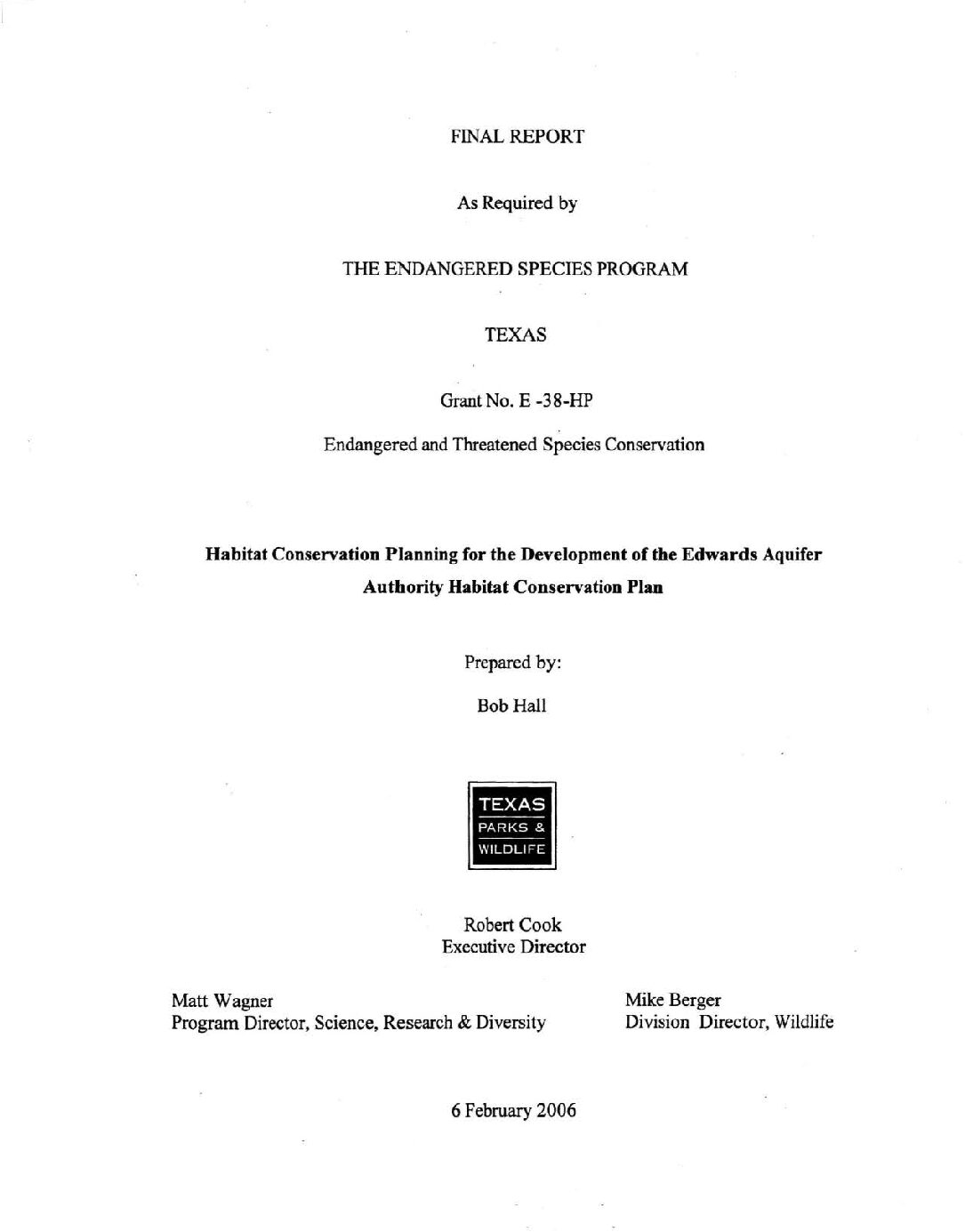
Description: Summary of progress on development of the Habitat Conservation Plan (HCP) to protect the Comal and San Marcos spring ecosystems and mitigate any incidental take of listed species that would occur as a result of low spring flows, and Environmental Impact Statement (EIS) for description of the preferred alternative
Report Number: Grant E-38-HP
Location: Comal Springs, San Marcos Springs, Atascosa County, Bexar County, Caldwell County, Comal County, Guadalupe County, Hays County, Medina County, Uvalde County
Summary:1) Inclusion of the results of additional biologic modeling and evaluation studies that were completed in 2003 and 2004. A revised Draft January 2004 HCP/EIS was completed and delivered to the Authority for internal review.
2) Holding a meeting with the USFWS staff on April 9, 2004 to discuss status of the HCP and to describe and discuss the concept of intensive management areas that would be developed on site to support the spring ecosystem species during periods of severe drought.
3) Holding a meeting with the Consultants on June 8, 2004 to discuss changes and revisions to the Draft January 2004 HCP/EIS. The changes and revisions were completed to the Draft January 2004 HCP/EIS by July 2004.
4) Reviewing the Draft July 2004 HCP/EIS by the Authority's Research and Technology Committee and the Authority's Board during meetings held in July, August and September 2004. Several amendments by Authority Board members were incorporated into the Draft July 2004 HCP/EIS.
5) Submitting the Draft July 2004 HCP/EIS, as Amended, to the USFWS, TPWD, other stakeholders and the general public for comment. Four public meetings were held by the Authority to receive public comments. These meetings were held in Victoria (November 1, 2004), New Braunfels (November 8, 2004), Uvalde (November 16, 2004), and San Antonio (November 17, 2004). In addition, a Biological Advisory Team meeting was also held on November 17, 2004 to discuss and receive comment and two facilitated meeting with major stakeholders were held February 9 and February 17, 2005.
6) Responding to comments on the Draft July 2004 HCP/EIS, as Amended. Withdrawal limits were removed from the document and the HCP was separated from the EIS. This was done because the issue of withdrawal limits are outside the control of the Authority and are not resolved at this time. Separating the HCP from the EIS was done to facilitate the review of the HCP. The EIS will be revisited, revised and included as either an integral part of the final HCP/EIS or as a stand alone document when the issues connected with withdrawal limits are resolved.
Task #4 is completed with this report.
Habitat conservation planning for development of the Edwards Aquifer Authority Habitat Conservation Plan: grant no. E-38-HP: grant program, Section 6 habitat conservation plan planning assistance

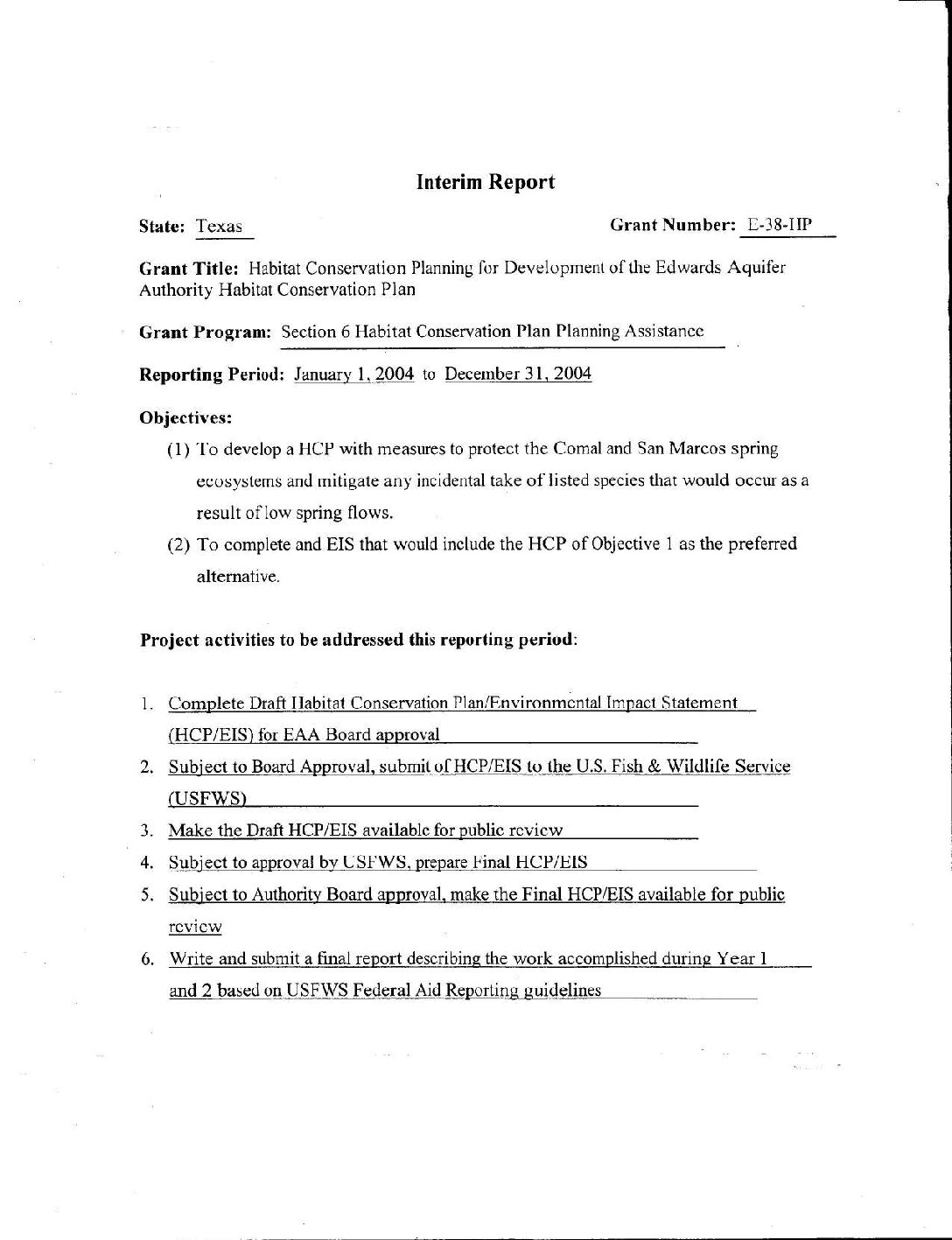
Description: Summary of progress to 2005 on development of the Habitat Conservation Plan (HCP) to protect the Comal and San Marcos spring ecosystems and mitigate any incidental take of listed species that would occur as a result of low spring flows, and Environmental Impact Statement (EIS) for description of the preferred alternative
Report Number: Grant E-38-HP
Location: Comal Springs, San Marcos Springs, Atascosa County, Bexar County, Caldwell County, Comal County, Guadalupe County, Hays County, Medina County, Uvalde County
Summary:1. Substantial changes were made to the draft HCP dated November 2002 based on comments received during 2003 from Authority staff, the HCP Work Group, Citizens Advisory Committee (CAC) and Biological Advisory Team (BAT), and results of additional modeling and evaluation studies that were also completed in 2003 and 2004.
A revised draft HCP/EIS was completed and delivered to the Authority for internal review in January 2004 (draft dated January 2004).
2. A meeting was held with USFWS staff on April 9, 2004 to discuss status of the HCP and to describe and discuss the concept of intensive management areas that would be developed on site to support the spring ecosystem species during periods of severe drought.
3. Consultants met with Authority staff on June 8, 2004, to discuss changes and revisions to the draft HCP/EIS dated January 2004, based on an intensive internal review by Authority technical and legal staff. In response to this intensive internal review additional changes and revisions were completed to the January 2004 draft HCP/EIS.
This resulted in Draft July 2004 HCP.
4. The Draft July 2004 HCP was reviewed and discussed by the Authority Board of Directors and the Board's Research and Technology Committee during several meetings held in the months of July, August and September 2004. Several amendments by Authority Board members were incorporated that resulted in the Draft July 2004 HCP, as Amended (CD included). This draft was released by the Authority Board to the general public and stakeholders for review and comments. Four public meetings were held by the Authority to receive public comment on the Draft July 2004 HCP, as amended. These meetings occurred at Victoria (November 1, 2004), New Braunfels (November 8 2004) Uvalde (November 16, 2004 ), and San Antonio (November 17, 2004 ). A BAT meeting was also held on November 17, 2004 to receive comment.
5. Public review on the Draft July 2004 HCP, as amended was still in progress at the end of 2004.
Significant Deviations
At the end of 2003, it was apparent that the complex nature of the project, the number of stakeholders with competing interests and the time required in the review and rewrite process would prevent the completion of this project in 2004. On March 16, 2004, Interlocal Agreement Contract between the Authority and State was extended through December 31, 2005.
Comprehensive and Critical Period Monitoring Program to Evaluate the Effects of Variable Flow on Biological Resources in the Comal Springs/River Aquatic Ecosystem Final 2012 Annual Report


Description: Annual report for 2012 on biota study of Comal Springs/River
Summary:[From the Executive Summary]
This annual summary report presents a synopsis of methodology used and an account of sampling activities conducted during two Comprehensive Monitoring efforts on the Comal Springs/River ecosystem in 2012. For ease of comparison, the data are reported here in an annual report format similar to previous reports (BIO-WEST 2001-2012).
The drought in Central Texas continued through 2012 and flows in the Comal River were below the historic average for the entire year. A minimum flow of 155 cubic feet per second (cfs) was reached in September, and it was the lowest minimum flow since the first year of this study (2000). With rain events few and far between, flows stayed near 200 cfs for the remainder of 2012. Although water temperatures remained constant in spring runs and Landa Lake, hot and dry conditions led to water temperatures in the mouth of Blieder's Creek that exceeded the state water quality standard for the Comal River (26.7 °C). Monitoring by Texas Master Naturalists continued to confirm that dissolved carbon dioxide (CO2) decreases and pH increases with distance from spring inputs. However, values for these parameters were similar to those observed in previous years. Recreation pressure was highest at the New Channel during the summer months, and was relatively low year-round at all other monitored sites.
Monitoring of aquatic vegetation during these prolonged droughts is important to understanding potential impacts to fountain darter (Etheostoma fonticola) habitat. Bryophytes (mosses) hold high densities of fountain darters and can be abundant within the Upper Spring Run Reach. This was the case in spring, but by fall many of the bryophytes had died likely due to shading by green algae that often bloom in summer with abundant sunlight. Sagittaria continued to be stable in the lower half of the reach. Bryophytes are also an important component of the upper section of the Landa Lake Reach.
Unlike the Upper Spring Run Reach, bryophytes at Landa Lake remained relatively constant over the entire year. Cabomba, another native plant with relatively high densities of darters has been increasing in coverage in Landa Lake, and by fall 2012 had the highest coverage observed in this study. Lower than average flows did not appear to negatively affect aquatic vegetation in the Landa Lake Reach in 2012. The Old Channel Reach exemplifies the interaction between native (Ludwigia) and non-native (Hygrophila) vegetation. Over the past several years Ludwigia has become sparse (filamentous algae is rarely present) while Hygrophila has come to dominate most of the reach. Cabomba flourished in the New Channel Reach in 2012, while coverage of Hygrophila was only slightly less in this scour-prone reach.
A high-flow event (7,280 cfs) in 2010 scoured out much of the vegetation in upper reaches of the Comal River resulting in low population estimates of fountain darters; however, by 2012 aquatic vegetation had recovered and fountain darter population estimates were similar to years prior to the flood. Estimates in the Upper Spring Run Reach decreased considerably from spring to fall due to the loss of bryophytes (which appears to be a regular cycle). These bryophytes hold the highest densities of fountain darters in the Comal River. Of non-native aquatic vegetation, Hygrophila holds the highest densities of darters.
Length-frequency distribution indicates that higher quality habitats exhibit year-round reproduction, whereas lower quality habitats (i.e., Hygrophila) typically only exhibit a spring reproductive peak. This may be tied to fountain darter spawning preferences, as other studies suggest that egg deposition in native vegetation is higher than in non-native vegetation (Phillips et al. 2011). Catches of exotic giant ramshorn snail (Marisa cornuarietis) have increased in 2011 and 2012. It is unclear if this is related to the ongoing drought, but monitoring will help determine if they are impacting aquatic vegetation. Additionally, continued monitoring of giant ramshorn snail will aid in evaluating the success of Edward's Aquifer Habitat Conservation Plan (EAHCP) measures aimed at controlling this exotic species.
Comal Springs salamander (Eurycea sp.) counts appeared to be increasing during 2012 following the post-flood decline in 2011 (the lowest during the study period). Few salamanders continue to be found at the Spring Island Spring Run, but this is likely a result of lower quality habitat compared to other reaches. A total of 749 Comal Springs Riffle Beetles (Heterelmis comalensis) were observed on cotton lures in 2012, the lowest total since 2003. Fewer have been found at Spring Island since the flood of 2010 because spring outlets have shifted locations, and riffle beetles may have moved.
The flood of 2010 impacted the biota and associated habitat in the Comal River, but monitoring efforts in 2012 indicate that much of the system has recovered. Aquatic vegetation is flourishing in all reaches, and fountain darter populations are similar to pre-flood estimates. The interaction between native and non-native vegetation will continue to be an important driver of fountain darter populations. As EAHCP efforts get under way in 2013, including aquatic vegetation restoration and non-native species control, continued monitoring is more important than ever to assess effectiveness of EAHCP activities.
Simulated Impacts Associated with the Cibolo Creek Transfers Using MODFLOW-NR and Senate Bill 3 Assumptions


Description: Tests of MODFLOW-NR and Senate Bill 3 assumptions on springflow in the Edwards Aquifer Balcones Fault Zone San Antonio Segment
Location: Edwards Aquifer, Balcones Fault Zone, San Antonio Segment
Summary:The Edwards Aquifer Authority has promulgated rules that regulate the approach by which a water producer can acquire additional water rights by purchase or by lease from other water right holders. Water right transfers from Bexar County and west into Comal and Hays Counties are referred to as Cibolo transfers because Cibolo Creek is the geographic feature between the two areas. The purpose of this study was to evaluate the impact of ground-water pumpage on aquifer water levels and springflow at Comal and San Marcos springs with the implementation of the Cibolo Transfer Rule. Using available data and the EAA MODFLOW groundwater model (with dry cell controls) to assess the impact of Cibolo transfers, the evaluation was based on five factors: geographic location relative to the springs, aquifer conditions (i.e., wet periods and drought), pumping rates of the transferred permits, critical period rules, and overall impact of the different scenarios on simulated springflow. Most of the Cibolo transfers originate in Bexar County and terminate in Comal County. Modeling results showed that permits transferred farther east have more impact on San Marcos springflow and slightly raise water levels in J-17 because pumping is shifted downgradient of J-17. Transfers may increase or decrease springflow at Comal Springs, but decrease springflow at San Marcos Springs. The decreases are exacerbated by higher summer pumping or during droughts. The study was completed on April 18, 2008 by LBG-Guyton Associates, Austin, Texas.
Executive Summary of Water Availability Study for the Guadalupe and San Antonio River Basins

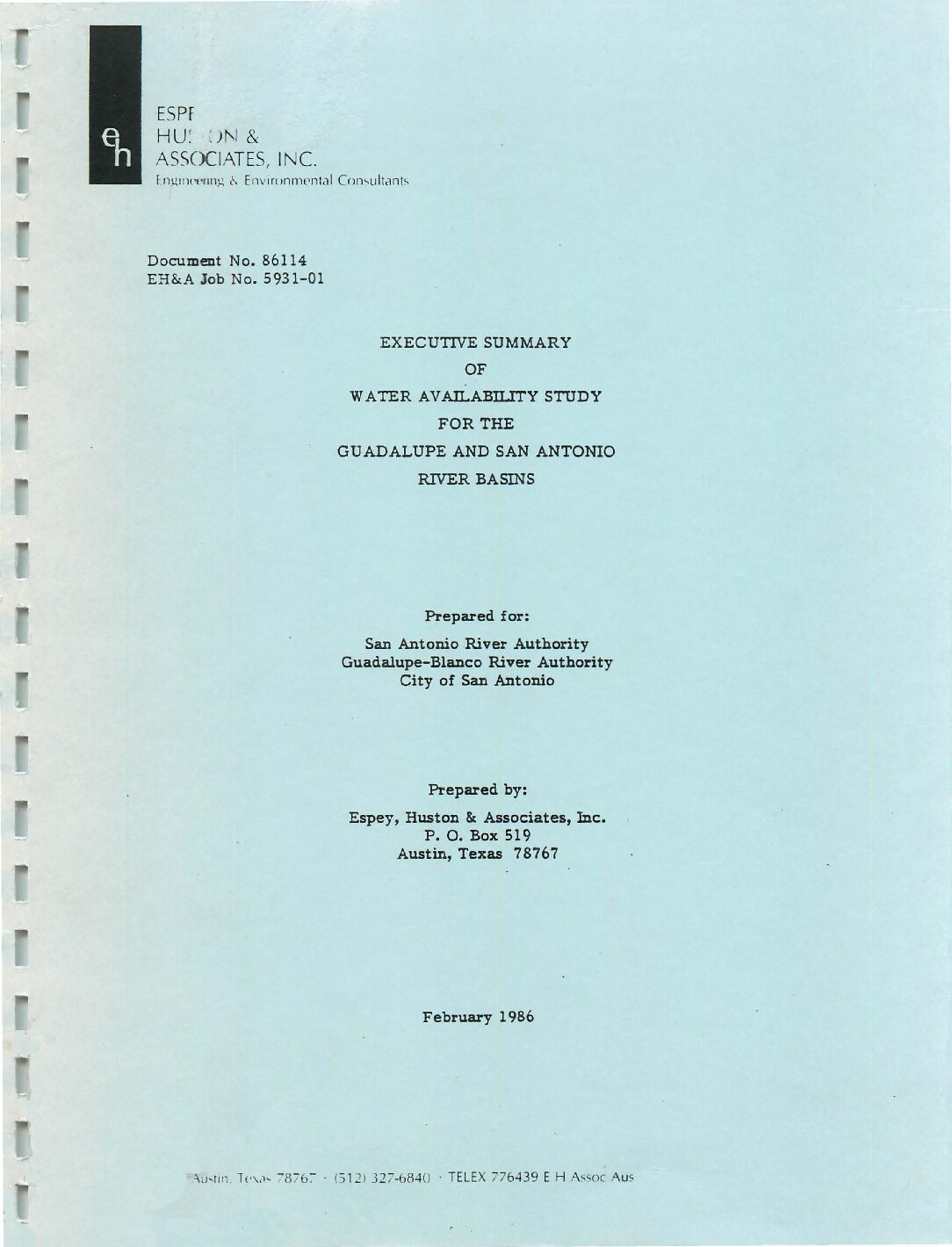
Description: Note: This paper is included for its historical value but has been replaced by more recent studies. Summary of studies on proposed reservoirs on the Guadalupe and San Antonio Rivers.
Location: Guadalupe River Basin, San Antonio River Basin
Summary:Note: This report is included because of its historical value. It has been replaced by more recent plans.
Environmental analyses indicate no fatal flaws nor significant permitting problems at any of the potential reservoir sites studied. Mitigation of impacts will be required at any of the sites, which can be provided at least, in part, by peripheral land usage around the proposed reservoirs. No threatened-or endangered vegetative, wildlife, or aquatic species are known to occur in any of the potential reservoir sites.
HYDROLOGY
Hydrologic evaluations indicate that substantial firm yields can be developed from the potential reservoir sites. Existing water rights play an extremely important role in the future availability of water for development. Existing gaged fiows do not yet refiect the full development of the existing water rights. Thus, even without additional reservoir projects, it can be expected that future flows within the rivers would decline as these water rights are developed.
Return flows by municipalities can play a dramatic role in the yield of any of the proposed reservoirs. The Goliad Reservoir benefits directly by having a dramatic increase in firm yield on virtually a one to one ratio for each gallon of water returned to the river by San Antonio. Less dramatic but equally important, return flows from San Antonio impact the ability of water-right holders below the confluence of the San Antonio and Guadalupe rivers to obtain their water rights.
Return flows also impact the ability to meet the demands of the bays and estuaries, which have been defined in these studies. Future policy decisions by the City of San Antonio regarding these return flows will have a dramatic impact on decision-making regarding reservoir development.
Reductions in springflows from the Comal and San Marcos springs would have a severe impact on the ability of existing water-right holders to obtain flows which they have historically used, and would also have a severe impact upon the flows into the bays and estuaries. Likewise, the yields of Canyon Reservoir and any proposed reservoir projects would be significantly reduced by this reduction in flow, should springflows continue to diminish. Future policy decisions by the City of San Antonio and others regarding withdrawals from the Edwards Aquifer will therefore significantly impact the development of future reservoir projects.
Freshwater inflow requirements to the bays and estuaries required to maintain viable biological habitat have, for the first time, been applied to reservoir firm-yield calculations. Bay and estuary flow requirements to maintain a viable habitat can be met, and will be exceeded in most years due to uncontrolled drainage areas and flood spills. Even providing for these bay and estuary requirements, significant yields can be developed from any of the potential reservoir sites.
Comprehensive and Critical Period Monitoring Program to Evaluate the Effects of Variable Flow on Biological Resources in the San Marcos Springs/River Aquatic Ecosystem Final 2003 Annual Report

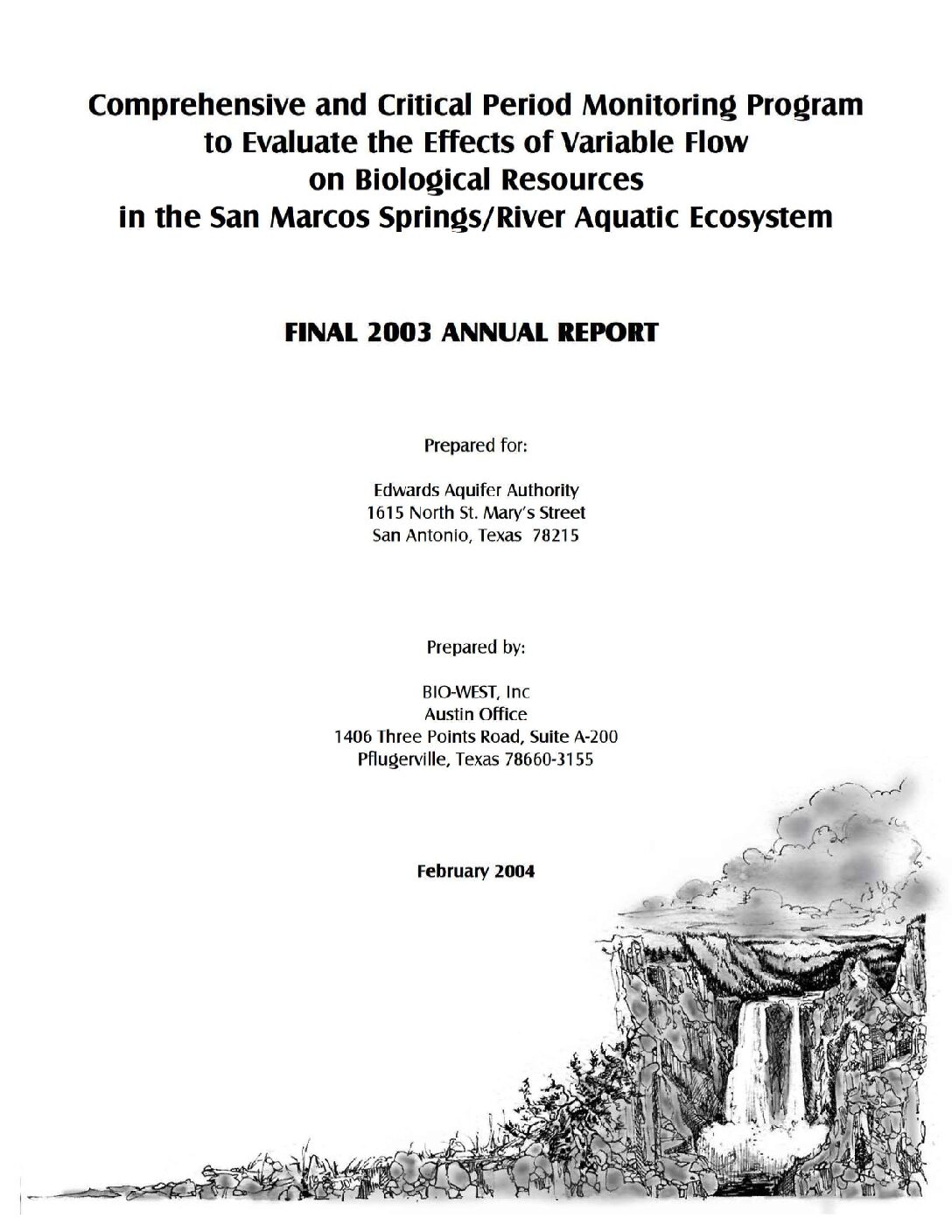
Description: Annual report for 2003 on biota study of San Marcos Springs/River
Location: San Marcos Springs/River
Summary:The purpose of this report is to document the results of all aquatic ecosystem monitoring conducted in 2003 at San Marcos Springs located in San Marcos, Texas. The monitoring and report preparation was performed by BIO-WEST, Inc. Pflugerville, Texas.
[Excerpted from Executive Summary]
This annual summary report presents a synopsis of methodology used and an account of sampling activities including sampling conditions, locations, and raw data obtained during three quarterly sampling events (Comprehensive Monitoring Effort) conducted on the San Marcos Springs/River ecosystem in 2003. There were no low-flow critical periods or high-flow events triggered in 2003. [D]ischarge steadily declined through 2003 (the lowest flow occurred on the final day of the year) and dropped to slightly below the historical average for the month of December.
Baseline data have continued to show that the San Marcos River is an ecosystem with high water quality according to the chemical and physical variables that were measured. Aquatic vegetation remained abundant throughout the study period and provided suitable habitat for biological communities.
As occurred in 2002, there was a substantial increase in total coverage of Texas wild-rice throughout the San Marcos River in 2003 relative to the previous sample. The scouring events in 2001 and 2002 have had a positive long-term impact on Texas wild-rice total coverage These scouring events appear to stimulate growth of individual stands and also result in displacement of small Texas wild-rice plants, which settle into new areas and grow rapidly. Stands of Texas wild-rice that remain in place after flooding are generally smaller, but they experience rapid growth.
Fountain darters were collected from each sample reach during each sampling event in 2003. The suitability of various vegetation types in the San Marcos River as habitat for fountain darters are similar. The size-class distribution for fountain darters collected by drop nets from the San Marcos Springs/River ecosystem in 2003 is typical of a healthy fish assemblage. However, the distribution is shifted towards larger fish than those observed in the Comal Springs/River ecosystem and this may be a function of lower quality habitat in the two sampled reaches compared with the Comal River reaches. Also, currents tend to be stronger in the San Marcos River reaches and may contribute to finding larger, but fewer, fish. In general, the number of fountain darters per net in the San Marcos River was much lower than in the Comal River. There also appears to be a seasonal trend in fountain darters collected in the San Marcos River of low abundance in the fall and winter with increasing abundance in the spring and into summer.
No giant ramshorn snails (Marisa cornuarietis) were observed in the San Marcos River in 2002 or 2003. However, because of the potential for a rapid population increase and the impact that this exotic species can have under heavier densities, close monitoring should continue. The gill parasite that has been reported to infect the fountain darter in the Comal system was not visually evident in fountain darters collected from the San Marcos system in 2003.
Estimated population densities of the San Marcos salamander in 2003 were consistent with observations in 2001-2002. [T]he sample site adjacent to the former Aquarena Springs Hotel consistently had the highest number of San Marcos salamanders. Population estimates have varied greatly between seasons at each site, overshadowing any seasonal or discharge-related trend that may be present. A lack of substantial lowflow data precludes discussion of potential influences of lower flows on the population at this time.
This study remains the most comprehensive biological evaluation that has ever been conducted on the San Marcos system.
Comprehensive and Critical Period Monitoring Program to Evaluate the Effects of Variable Flow on Biological Resources in the San Marcos Springs/River Aquatic Ecosystem Final 2010 Annual Report

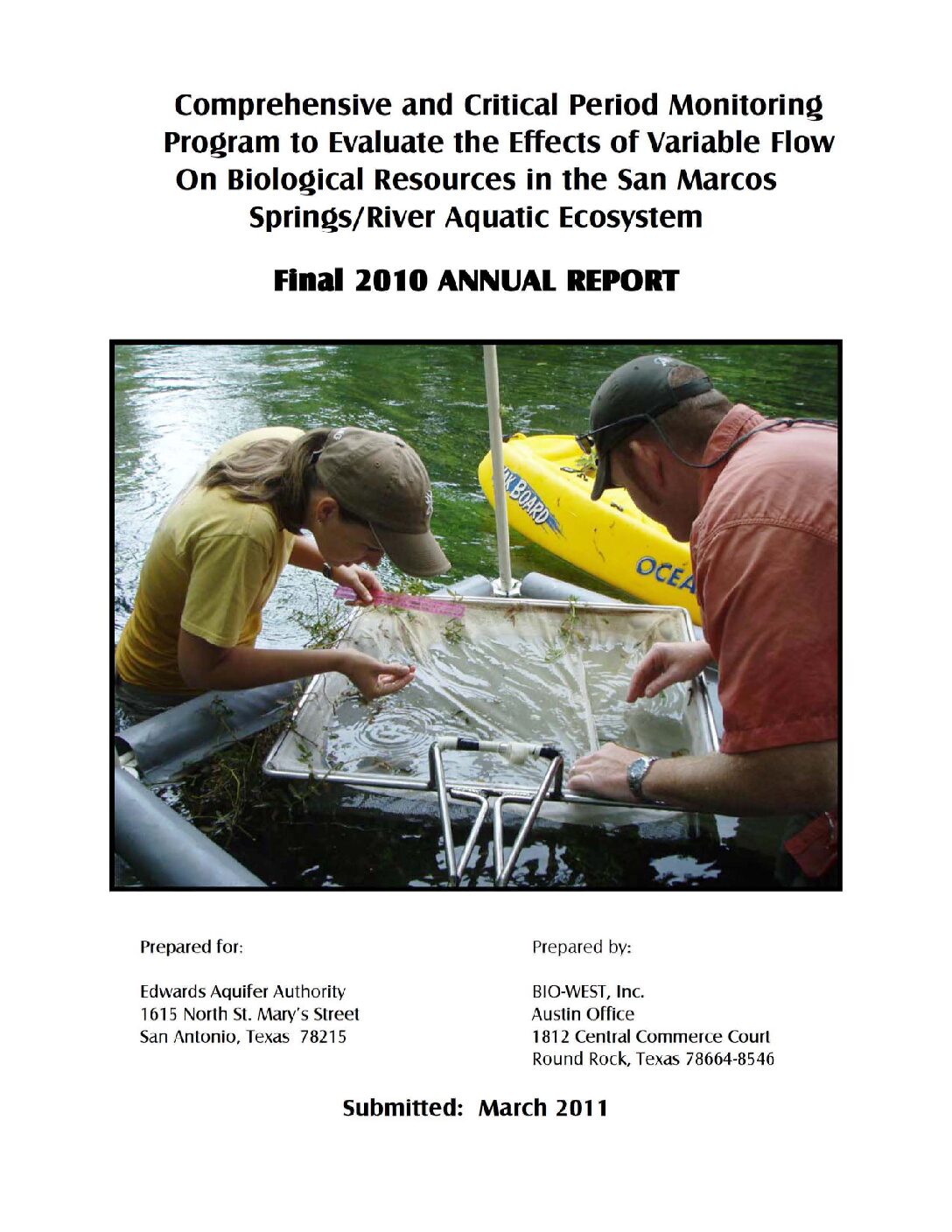
Description: Annual report for 2010 on biota study of San Marcos Springs/River
Location: San Marcos Springs/River
Summary:The purpose of this report is to document the results of all aquatic ecosystem monitoring conducted in 2010 at San Marcos Springs located in San Marcos, Texas. The monitoring and report preparation was performed by BIO-WEST, Inc. Pflugerville, Texas.
[Excerpted from Executive Summary]
This annual summary report presents a synopsis of methodology used and an account of sampling activities conducted during two Comprehensive Monitoring sampling efforts on the San Marcos Springs/River ecosystem in 2010. Unlike 2009, discharge in the San Marcos River was above the historical average to begin 2010. This was a considerable departure from the drought central Texas experienced over the previous couple of years. Discharge remained above the historical average until rainfall began to decrease in fall, and flows ended the year slightly below average.
Coverage of Texas wild-rice (Zizania texana) increased from fall 2009 to summer 2010 with an increase of nearly 500 meters squared (m2) in the uppermost section of the San Marcos River.
Flow conditions and recreational pressure in 2009 led to drastic changes in aquatic vegetation resulting in the lowest fountain darter (Etheostoma fonticola) population estimate (normalized estimate calculated based on average fountain darter density per vegetation type over the study period multiplied by aquatic vegetation coverage) of the study in fall 2009. A return to above average flow conditions provided a great opportunity to evaluate how the fountain darter population would recover from the extended lowflow period witnessed in 2009. As summarized above, the aquatic vegetation made a strong recovery which translated into a positive recovery for the fountain darter population as well. In fact, using the same methodology for calculating normalized population estimates, the 2010 fountain darter population estimate was the highest since the study's inception. Overall, there is little variation in the average density of fountain darters found among vegetation types in the San Marcos River. As a result, shifts in aquatic vegetation don't result in dramatic changes in fountain darter densities. Size class distributions indicate that reproduction occurs year-round (most pronounced in Spring Lake), with reproductive peaks in the spring.
San Marcos Salamander (Eurycea nana) densities increased at each site from fall 2009 to spring 2010 as flow increased above the historical average. Fall densities decreased at all sites with the largest drop at the site in the eastern arm of the San Marcos River immediately downstream of Spring Lake.
The recent drought in central Texas provided a unique opportunity to observe the biota and associated habitat in the San Marcos River over an extended period of lower than average flows. Above average flows in 2010 yielded a chance to observe how the biota and associated habitat recovered in areas that had experienced impacts during the drought. Continued monitoring of this system will provide knowledge on the organisms' interactions with variable flows, and also temporal responses that can only be detected over an extended period of time.
Comprehensive and Critical Period Monitoring Program to Evaluate the Effects of Variable Flow on Biological Resources in the San Marcos Springs/River Aquatic Ecosystem Final 2009 Annual Report

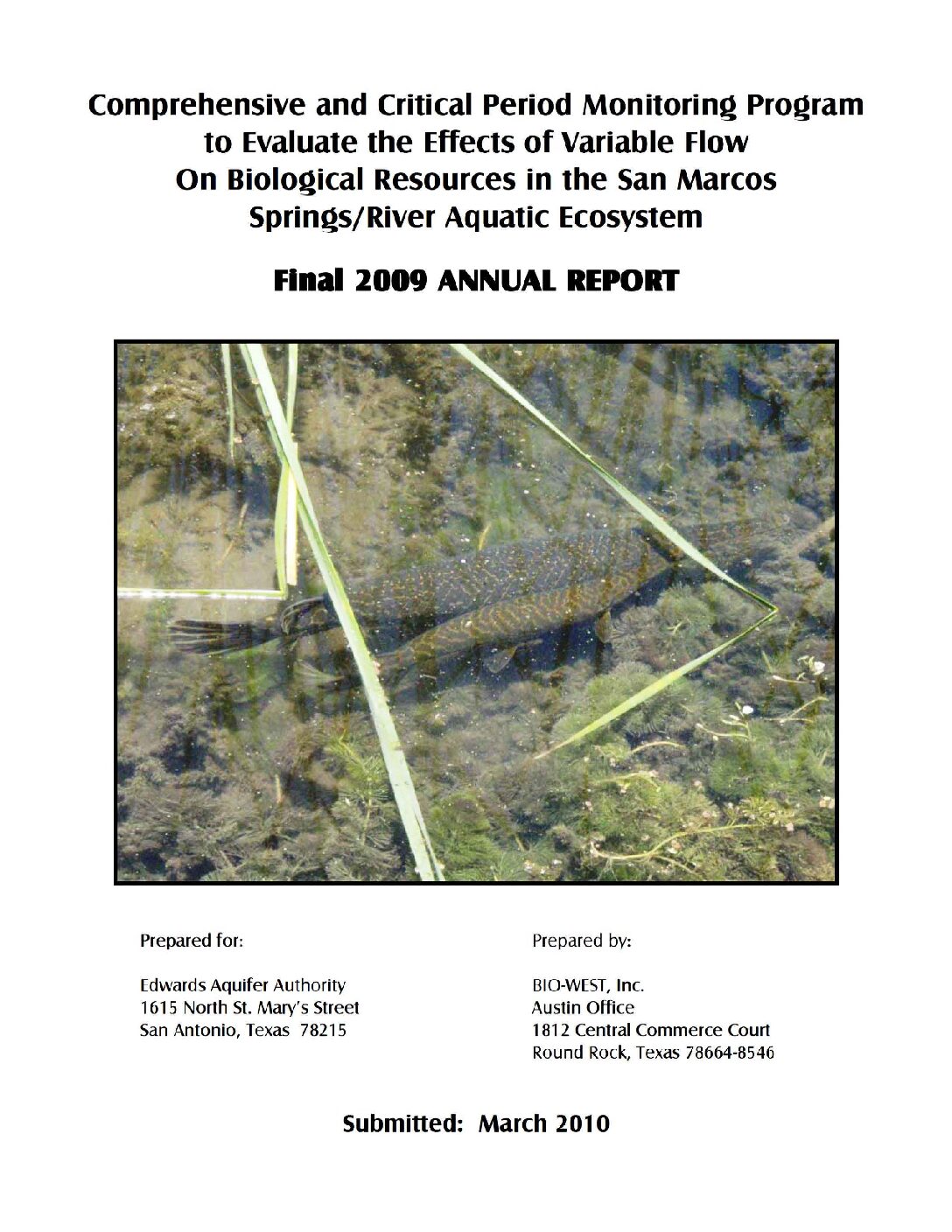
Description: Annual report for 2009 on biota study of San Marcos Springs/River
Location: San Marcos Springs/River
Summary:The purpose of this report is to document the results of all aquatic ecosystem monitoring conducted in 2009 at San Marcos Springs located in San Marcos, Texas. The monitoring and report preparation was performed by BIO-WEST, Inc. Pflugerville, Texas.
[Excerpted from Executive Summary]
This annual summary report presents a synopsis of methodology used and an account of sampling activities conducted during five full sampling events (two Comprehensive Monitoring events and three Critical Period low-flow events) on the San Marcos Springs/River ecosystem in 2009.
Discharge in the San Marcos River in 2009 decreased to levels not observed since this study began in 2000. Springflow was under 100 cubic feet per second (cfs) for 243 days (157 consecutively), with a minimum flow of 83 cfs in June, which was the lowest minimum flow in the river since 1996 (76 cfs). Springflow remained below 120 cfs for three quarters of the year (275 days). Mean monthly flows were below historic average flows for 18 straight months (dating back to March 2008). A myriad of effects were observed as a result of these low flows including elevated water temperatures, changes in aquatic vegetation coverage, and changes in channel morphology. Conditions experienced in 2009 allowed a comprehensive evaluation of the biota over an extended period of time with lower than average flows in the system.
[W]ater chemistry (conductivity, pH, dissolved oxygen, etc.) were similar to the previous Critical Period low-flow event in 2006. Water temperatures exceeded 26.67 ºC (water quality standard set forth by the Texas Commission on Environmental Quality [TCEQ]) at three sites in 2009. Low flows coupled with recreation pressure in summer resulted in the least amount of aquatic vegetation coverage in the City Park Reach since the study's inception.
Texas wild-rice (Zizania texana) coverage experienced similar declines in 2009, with decreases a result of both lower than average flows and recreational pressure. Overall, the total amount of Texas wild-rice decreased by 14% from summer 2008 to fall 2009. This was the lowest total amount since the Critical Period low-flow event in 2006. However, since this program first started measuring the total amount of Texas wild-rice in the river in 2001, it has shown a steadily increasing trend (with occasional decreases). The highest recorded total area of Texas wild-rice measured in the San Marcos River since the inception of the study occurred in January 2009. This year (2009) was the first year in which coverage of Texas wild-rice was quantified in winter (January), when recreation pressure is at its lowest. As the lower than-average flows of 2009 continued and winter gave way to summer, the total area of Texas wild-rice began to decrease.
Changes in aquatic vegetation observed in 2009 influenced fountain darter (Etheostoma fonticola) habitat, and thus, population estimates. As stated earlier, by fall 2009 the middle portion of the City Park Reach had become shallower and much of the Hydrilla and Potamogeton that occupied this area had been uprooted. Since fountain darter population estimates are based on vegetation coverage, the population estimate of fountain darters in this reach declined. In fact, fall 2009 exhibited the lowest overall population estimate of the study period (2000 2009). However, it is important to note that this is based solely on changes in vegetation coverage. When fountain darter density is analyzed by sample event, the overall density for City Park Reach in fall 2009 (8.6/m2) is considerably higher than the long-term average for this reach (4.4/m2). Additional analysis was conducted in 2009 to further explore the relationship between fountain darter abundance/density and discharge. When analyzed over the entire study period, total abundance and overall density show a negative relationship with discharge. That is, as discharge increases, abundance and density of darters decreases. This may be related to darters becoming concentrated into more limited habitat under lower flow conditions or decreased sampling efficiency under high flows.
San Marcos Salamander (Eurycea nana) populations did not appear to be affected by the lower than average flows in the San Marcos River in 2009.
The recent drought in Central Texas provided a unique opportunity to observe the biota in the San Marcos River over an extended period of lower than average flows. Multiple sampling efforts in 2009 provided valuable data on the effects of these flows combined with increased summer recreational pressure. Immediate effects of this pressure were apparent for Texas wild-rice and other aquatic vegetation types, and thus also influenced important fountain darter habitat. However, other study components such as San Marcos salamanders did not appear to be directly affected. Initial conditions and their effects are similar to those observed in 2006 when discharge was also below average.
Comprehensive and Critical Period Monitoring Program to Evaluate the Effects of Variable Flow on Biological Resources in the San Marcos Springs/River Aquatic Ecosystem Final 2012 Annual Report


Description: Annual report for 2012 on biota study of San Marcos Springs/River
Summary:This annual summary report presents a synopsis of methodology used and an account of sampling activities conducted during two Comprehensive Monitoring sampling efforts on the San Marcos Springs/River ecosystem in 2012. For ease of comparison, the data are reported in an annual report format similar to previous reports (BIO-WEST 2001a, b 2012a, b).
Flows in the San Marcos River began the year below the historic average, but spring rains bumped flows above 200 cubic feet per second (cfs) from April to July. This was the first time since October 2010 that flows were above 200 cfs. Summer and fall saw little rainfall resulting in flows declining to below 125 cfs to end the year. The minimum discharge in 2012 was 100 cfs (this occurred several times in January). These lower than average flows are a reflection of the ongoing drought in Central Texas.
Close to spring inputs there was little variation in water temperatures even though flows were below average. Water temperatures were highest at Sessom's Creek (tributary heavily influenced by runoff) and Rio Vista Dam (where water is pooled by the rapids downstream).
Total amounts of aquatic vegetation in each of the three reaches (Spring Lake Dam, City Park, and I-35) were below the fall and spring averages observed in this study. Vegetation at the City Park Reach is
most susceptible to seasonal changes due to varying amounts of recreation. In 2012, vegetation increased over winter, and decreased by the end of summer with large areas in the upper section (where recreation pressure is greatest) denuded of vegetation. This boom/bust cycle is typical of this reach, and
is the result of increased recreation pressure combined with effects of the extended drought. Aquatic vegetation at the Spring Lake Dam reach follows a similar pattern as City Park with plants growing over winter, and decreasing by fall. Recreation pressure here is also significant in summer since it is adjacent to a popular swimming area and high density housing, but recently-constructed educational signs may provide value. The greatest impacts on aquatic vegetation in recent years have been observed within the I-35 Reach. Since Rio Vista Dam was transformed into a flow-through rapid in 2006, sedimentation has apparently increased resulted in decreased depths and higher velocities, leading to much lower coverage of vegetation, especially in the upper section of this reach. Additionally, two large riparian trees have fallen into the river within this reach, diverting flow and scouring out areas that were previously covered in vegetation. By fall 2012, total area of aquatic vegetation dropped below 300 square meters (m2), the lowest ever observed in this study. These impacts are significant because the largest patches of Cabomba are found here which hold higher densities of fountain darters relative to other San Marcos aquatic vegetation. This section will continue to be closely monitored for other major changes in habitat.
Coverage of Texas wild-rice (Zizania texana) increased by 16% since 2011 resulting in the highest amount (4,367.1 m2) observed in the San Marcos River since the inception of the study. The largest increases were observed within the upper-third of the river where most of the wild-rice is located. Although one large stand at Sewell Park continues to shrink due to sedimentation blocking flow from the upstream end; however, other plants in the area continue to flourish. Texas wild-rice from the City Park Reach to Bicentennial Park increased by 35% from 2011. Coverage of wild-rice in areas downstream changed little over the year. Physical observations of vulnerable Texas wild-rice plants documented changes in several individual plants during 2012. More plants were emergent and
flowering in spring than in fall. Vegetation mats covering wild-rice were less prevalent in 2012 compared to previous years, likely a result of slightly higher flows. The mats can inhibit photosynthesis and cause plants to die if they are not pushed off (either manually or during higher flow events).
Population estimates of fountain darters (Etheostoma fonticola) were relatively high in spring 2012, but decreased to the lowest estimate observed in the study (2000 2012) by fall. These estimates are based on aquatic vegetation coverage and consequently follow the same pattern. Continued effects of the dam and recreation pressure during the summer both caused decreases in aquatic vegetation coverage in the I-35 Reach. This was exacerbated by a fallen tree which diverted flow and scoured out a previously vegetated area. As discharge increases, the number of fountain darters in each drop net tends to
decrease. This may be a result of clumping of darters into limited habitat under lower flows. Cabomba (native) and Hydrilla (non-native) exhibit the highest densities of fountain darters in the San Marcos River. These densities are typically lower than in the Comal River system. Dip net data reflects the importance of filamentous algae and bryophytes present in Spring Lake to fountain darter reproduction. These two vegetation types hold the highest densities of darters in both the Comal and San Marcos systems, but are not found in the San Marcos River downstream of Spring Lake.
San Marcos salamander (Eurycea nana) densities were typically higher than average in 2012 at all sites. The highest densities were observed at the Hotel Reach where bryophytes are abundant resulting in higher quality habitat. Salamander densities in this area were higher than the study average in both
spring and fall. Densities of salamanders rebounded at the Riverbed Reach in 2012 after construction activities in 2011 led to fewer salamanders. Numbers were slightly above the study average for both spring and fall. Throughout the study, salamander densities have been most variable at Sample Area 21
(~ 5 meters from the dam) because it is below Spring Lake Dam in an area of public access. This site exhibits higher velocities and typically less aquatic vegetation than areas in Spring Lake. Additionally, rocks that salamanders use for cover are often moved due to recreation activities. While spring densities
were similar to previous years, the density in fall was the second highest recorded in the study. Educational signage recently placed in this area is designed to increase public awareness of the sensitive species present, and will hopefully reduce habitat disturbance.
In conclusion, although Central Texas continues to be plagued by a drought, 2012 monitoring activities suggest that populations of threatened and endangered species in the San Marcos Springs/River Ecosystem continue to persist despite the mixed effects of the drought. In fact, coverage of Texas wild-rice reached a new monitoring plan high. Similarly, San Marcos salamander densities were above study averages. In contrast, fountain darter population estimates reached a new low in 2012. However, a spring rebound in population estimates is typically experienced, and is expected by spring 2013. Should
continued low flows persist in summer 2013, fountain darter habitat loss will likely continue due to the combined effects of persistent low flows and recreation within study reaches. Therefore, continued monitoring of aquatic vegetation communities and fountain darter populations is particularly important
in coming years. Additionally, continued monitoring of all study components will allow for assessing the effectiveness of Edward's Aquifer Habitat Conservation Plan (EAHCP) activities being implemented in 2013 and beyond.
Comprehensive and Critical Period Monitoring Program to Evaluate the Effects of Variable Flow on Biological Resources in the San Marcos Springs/River Aquatic Ecosystem Final 2008 Annual Report

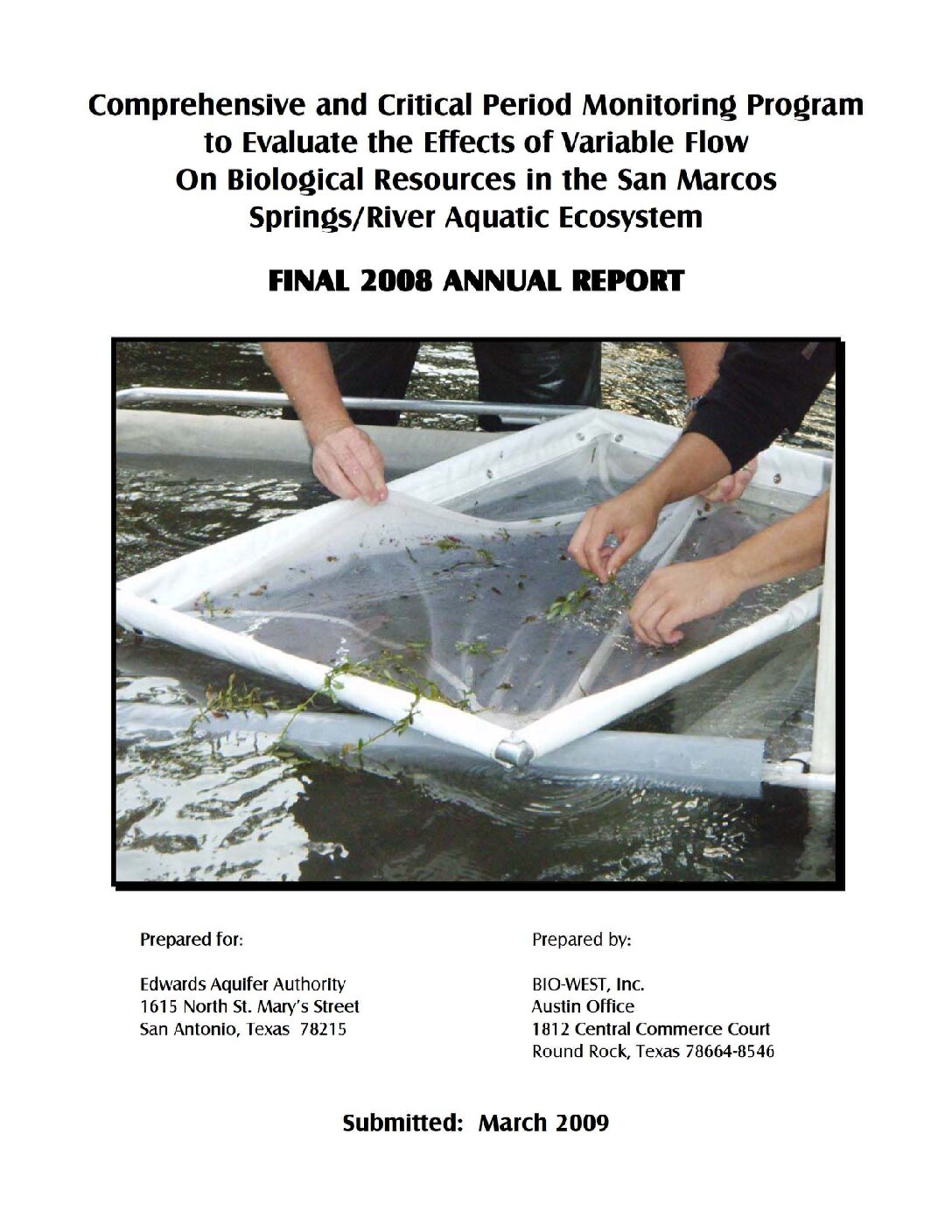
Description: Annual report for 2008 on biota study of San Marcos Springs/River
Location: San Marcos Springs/River
Summary:The purpose of this report is to document the results of all aquatic ecosystem monitoring conducted in 2008 at San Marcos Springs located in San Marcos, Texas. The monitoring and report preparation was performed by BIO-WEST, Inc. Pflugerville, Texas.
[Excerpted from the Executive Summary]
This annual summary report presents a synopsis of methodology used and an account of sampling activities including sampling conditions, locations, and data obtained during Comprehensive Monitoring Efforts conducted on the San Marcos Springs/River ecosystem in 2008. Very few precipitation events in the region contributed to below average flows in the river throughout the year. Discharge peaked at the beginning of the year and continued to decline through December where flows declined below 100 cubic feet per second (cfs). This flow level is designed to trigger Critical Period sampling. However, because the Fall Comprehensive Effort was completed in late October / early November at approximately 106 cfs, it was determined that a full Critical Period sampling event will be performed in January 2009 (approximately 60 days post Fall Comprehensive sampling) provided flows remain below 100 cfs.
For the fountain darter (Etheostoma fonticola), habitat use is largely influenced by aquatic vegetation, and assessments of habitat availability were conducted by mapping vegetation in the study reaches during each sampling event. With flows below average in 2008 there was a greater potential for anthropogenic disturbance because vegetation in shallow water areas became more accessible to recreation. This was observed at the Spring Lake Dam Reach between summer and fall where a section of Texas wild-rice plants appeared to be uprooted in the eastern spillway below Spring Lake. In addition, many rocks were moved to create dams and other structures in the area.
Vegetation in the City Park Reach increased by spring 2008, but decreased by fall. Lower flows in 2008 made typically deeper sections of this reach accessible to foot traffic during the summer and fall. As a result, Hydrilla decreased in surface are in the middle section of the reach. Hygrophila was one of the few vegetation types that increased when it filled in a section previously dominated by Sagittaria in the upper section of the City Park Reach.
Texas wild-rice increased 7 percent in surface area from 2007 and was the highest amount recorded by BIO-WEST since the inception of the study in 2001. As in previous years, most of the growth took place in the upper reaches of the San Marcos River.
As in 2007, fountain darter densities were highest in Cabomba and Hydrilla. Cabomba is a native vegetation type, while Hydrilla is non-native and considered to be very invasive. More fountain darters were found in the spring at the I-35 Reach than at the City Park Reach due to the presence of Cabomba. As in previous years, fountain darters collected in dip net sampling were most abundant at the Hotel Reach. Length frequency analysis confirmed a spring reproductive peak of this endangered fish at all river sites. Fountain darter reproduction continues to be a year-round phenomenon within Spring Lake.
San Marcos salamander (Eurycea nana) densities increased at both Spring Lake sites in 2008 while decreasing slightly at the site below Spring Lake dam. Of the federally-listed species in the San Marcos system, the San Marcos salamander appears to be the least affected by lower flow conditions periodically observed over the time period covered by this study. The impacts when observed are typically due to increased recreational use of the river. Populations of San Marcos salamanders in Spring Lake have remained stable throughout the seven plus years of monitoring.
The past several years have exhibited different yearly flow regimes leading to a very informative flow sequence in the San Marcos River. After the lower flows of 2006, 2007 was a relatively average flow year, while 2008 was again considerably below average. Overall, the biological communities in the river have responded well to the flow sequence experienced these past several years. If the current drought continues, 2009 may provide a valuable opportunity to examine how these species and their habitats respond to extended durations of lower flow conditions or more extreme low-flow conditions
Comprehensive and Critical Period Monitoring Program to Evaluate the Effects of Variable Flow on Biological Resources in the San Marcos Springs/River Aquatic Ecosystem Final 2007 Annual Report

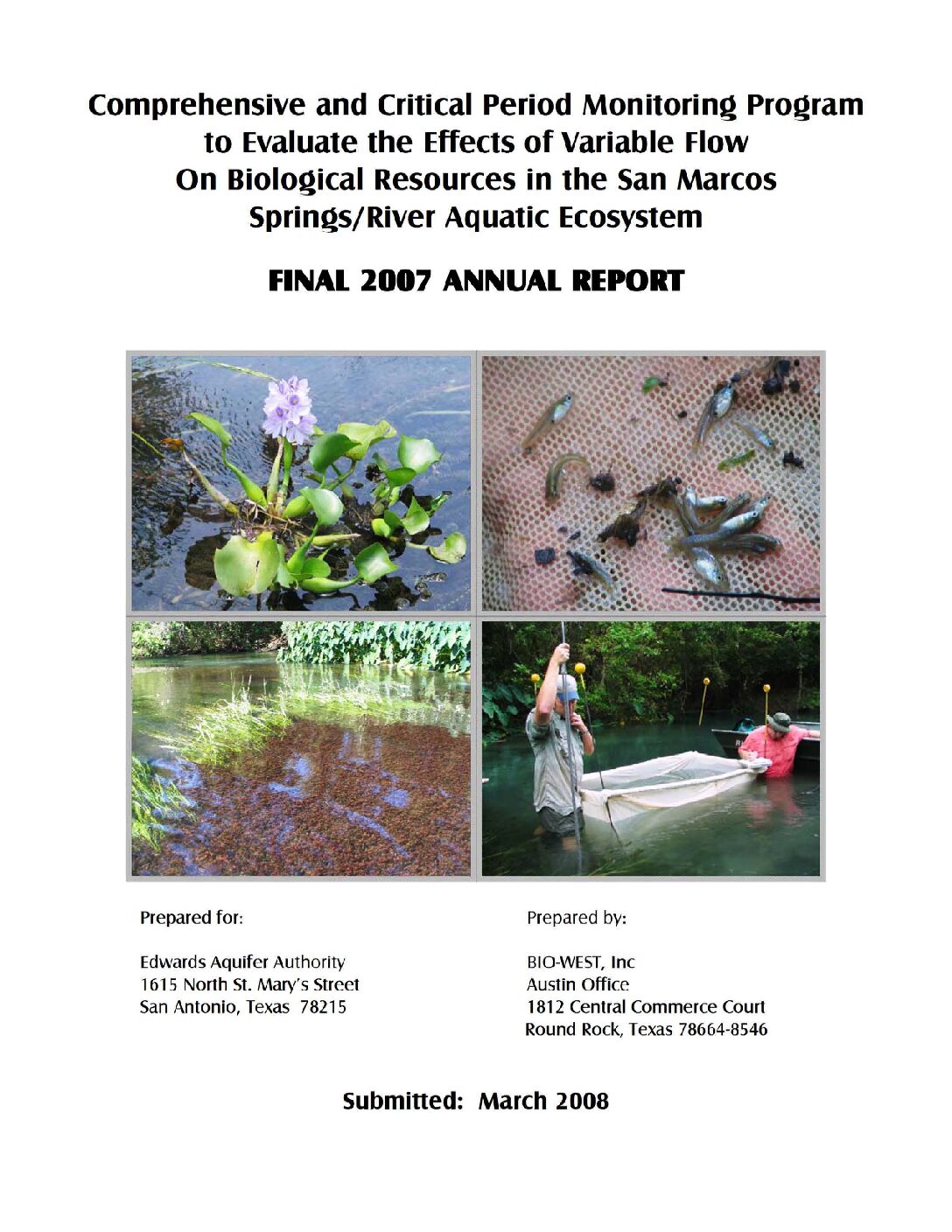
Description: Annual report for 2007 on biota study of San Marcos Springs/River
Location: San Marcos Springs/River
Summary:The purpose of this report is to document the results of all aquatic ecosystem monitoring conducted in 2007 at San Marcos Springs located in San Marcos, Texas. The monitoring and report preparation was performed by BIO-WEST, Inc. Pflugerville, Texas.
[Excerpted from Executive Summary]
This annual summary report presents a synopsis of methodology used and an account of sampling activities including sampling conditions, locations, and data obtained during two sampling events (Comprehensive Monitoring Effort) conducted on the San Marcos Springs/River ecosystem in 2007. Limited recharge in the river in 2006 led to decreased flows in the system to start 2007, which is when the lowest discharge in the river was recorded this year. Significant precipitation events in winter and summer resulted in flows well above the historical average throughout the year.
Overall, aquatic vegetation in the San Marcos River decreased in 2006 because of direct and indirect effects of the low flows. Increased flows in 2007 appeared to stimulate growth and encourage colonization of areas that were bare as a result of mechanical disturbance in 2006 Texas wild-rice (Zizania texana) was the most vulnerable plant to mechanical disturbance in 2006 decreasing nearly 75% in this reach after people pulled out many of the leaves. Fortunately, many of the root-wads remained, and in 2007 these roots enabled the plants to recover relatively quickly in the higher flows. Texas wild-rice plants in the eastern arm of the reach increased their surface area several times, and several new plants were also found. Downstream, plants that had been disturbed in 2006 began to grow back together, and seeds could be seen by summer. Educational signs placed along the banks in this reach were a great contribution to educating the public about wild-rice and other endangered organisms in the system. The City Park Reach exhibited a similar resurgence in vegetation area.
The suitability of the various vegetation types (as measured by fountain darter density) is considerably lower in the San Marcos River when compared with the Comal River. As expected, fountain darter densities were highest in Cabomba and surprisingly, Hydrilla. It is unclear why Hydrilla was a preferred habitat in 2007, but further monitoring may provide an answer. Similar to previous years, the smallest darters were captured in spring indicating a spring reproductive peak.
Exotic species continue to inhabit the San Marcos River, but did not appear to have any noticeable impacts during 2007. San Marcos salamanders (Eurycea nana) continued to be common in Spring Lake where large areas are covered in filamentous algae. Salamander density below Spring Lake Dam was near the highest observed since the inception of this study.
Following an extremely low flow year (2006) in the San Marcos River, the biological communities responded well in 2007. Texas wild-rice re-colonized several areas where it had been previously stripped, and estimates of fountain darters continued to be high.
Comprehensive and Critical Period Monitoring Program to Evaluate the Effects of Variable Flow on Biological Resources in the Comal Springs/River Aquatic Ecosystem Final 2007 Annual Report

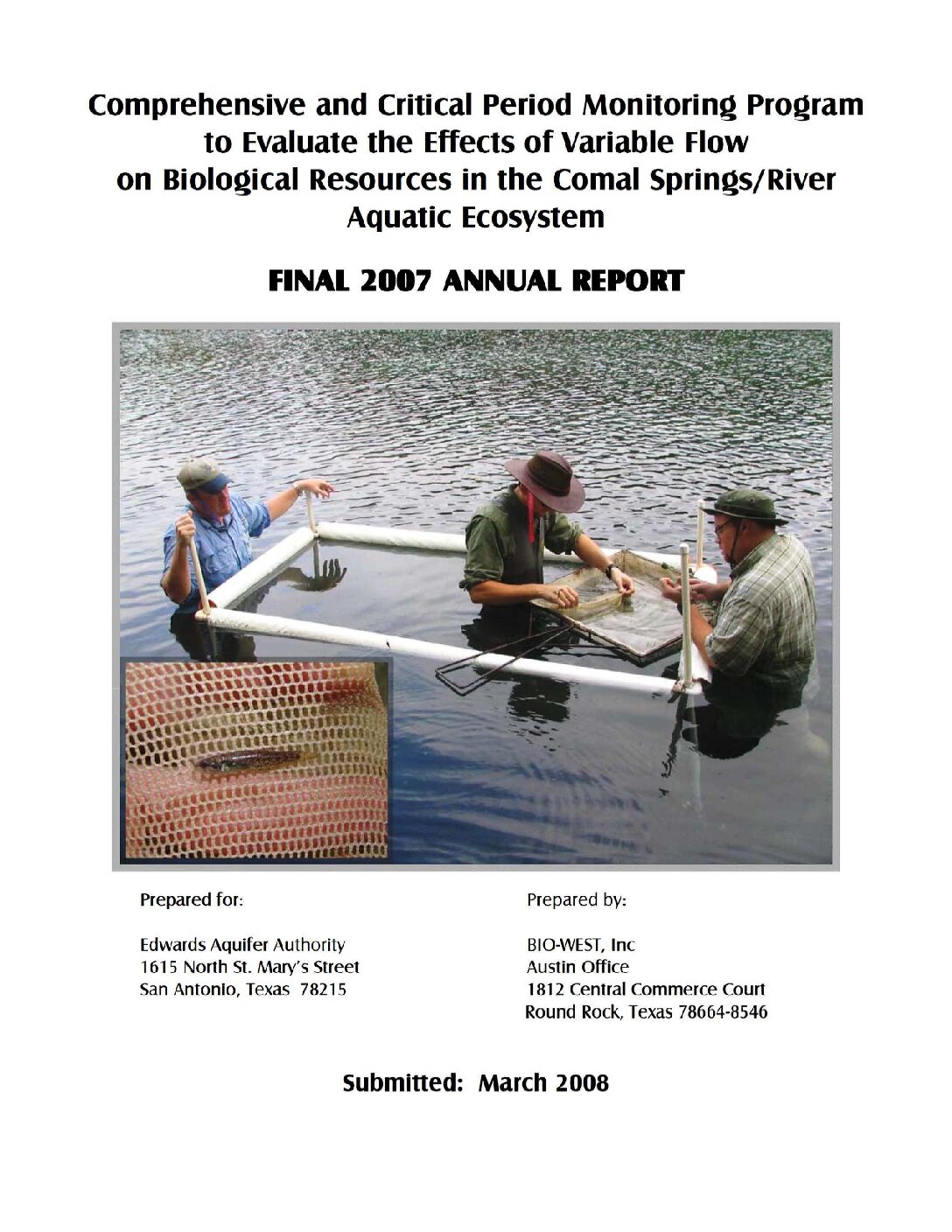
Description: Annual report for 2007 on biota study of Comal Springs/River
Location: Comal Springs/River
Summary:The purpose of this report is to document the results of all aquatic ecosystem monitoring conducted in 2007 at Comal Springs located in New Braunfels, Texas. The monitoring and report preparation was performed by BIO-WEST, Inc. Pflugerville, Texas.
[Excerpted from the Executive Summary]
This annual summary report presents a synopsis of methodology used and an account of sampling activities, including sample conditions, locations and raw data obtained during two sampling events (Comprehensive Monitoring Effort) conducted on the Comal Springs/River ecosystem in 2007.
In 2007, precipitation events during the first half of the year contributed to flows above the historical average for three-quarters of the year. A considerable rain event occurred in July and the flow in the river peaked at 1,980 cfs.
Higher flows following a below average discharge year had a myriad of effects on the biota in the Comal River/Springs Ecosystem. Aquatic vegetation continued to flourish, but in some reaches non-native plants continued to outcompete native flora. This may affect fountain darter populations in the future as these fish prefer native vegetation. In addition, another native plant, Cabomba, was no longer observed in [the Upper Spring Run] reach in 2007. Vallisneria was the dominant vegetation in the Landa Lake reach in 2007 The interplay between native and non-native vegetation was observed in this reach in 2007. From fall 2006 to spring 2007 Hygrophila stands in the central portion of the reach swelled, while Ludwigia in this area decreased. By fall 2007, Ludwigia surface area increased, while Hygrophila in the same region decreased. This trend has continued for several years and may have an important effect on fountain darter populations because sampling has shown that darters prefer Ludwigia to Hygrophila.
Drop-netting continues to be the best method for sampling fountain darters in varied vegetation types without harming the endangered fish. Although flows were higher this year, bryophytes were present throughout much of the Upper Spring Run and Landa Lake reaches. This led to the highest population estimates in these reaches since 2003. As in previous years data reflected a spring reproduction peak of this species based on length frequency distributions showing the smallest fish present in spring.
Snorkel surveys of salamanders in the spring runs exhibited a slight increase from 2006 with total numbers at or slightly above average. Fourteen different invertebrate taxa were observed at three drift net sites within Comal Springs in 2007. In 2007, four different species of Stygobromus were collected within the Comal Springs making it (and the San Marcos Springs) the only locality in North America with four co-occurring Stygobromus species. Fewer individuals of the Comal Springs riffle beetle (Heterelmis comalensis) were collected in 2007, which was likely related to mechanical disturbance to several of the cotton rags used in capturing them. [F]urther study is needed to understand the effects of [the gill] parasite at low-flows.
Overall, the higher discharge in 2007 positively affected fountain darter and plant growth. However, it appeared that in some reaches non-native vegetation continues to outcompete the native flora. This may have serious effects on fountain darter populations in certain reaches.
Though the comprehensive portion of the study has been reduced to two annual samples (plus a limited summer effort), it is still adequate to maintain a continuous record of conditions. Maintaining this continuous record is vital since antecedent conditions influence community-level response to reduced discharge conditions. Sampling only during a low-flow event simply does not provide the necessary context to adequately assess changes that occur during such conditions. As such, comprehensive monitoring will continue in the Comal Springs/River ecosystem in 2008.
 Conditions
Conditions

 CURRENT
CURRENT 
